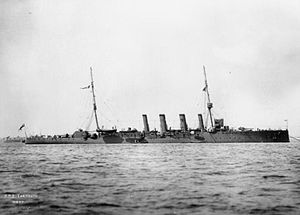HMS Yarmouth (1911)

Yarmouth in 1912
|
|
| History | |
|---|---|
|
|
|
| Name: | HMS Yarmouth |
| Namesake: | Great Yarmouth |
| Builder: | London & Glasgow Co. |
| Laid down: | 27 January 1910 |
| Launched: | 12 April 1911 |
| Commissioned: | April 1912 |
| Fate: | Sold for scrapping 2 July 1929 |
| General characteristics (as built) | |
| Class and type: | Town-class light cruiser |
| Displacement: | 5,275 long tons (5,360 t) |
| Length: | |
| Beam: | 47 ft 6 in (14.5 m) |
| Draught: | 15 ft 6 in (4.72 m) (mean) |
| Installed power: |
|
| Propulsion: | 2 × shafts; 2 × Brown-Curtis steam turbines |
| Speed: | 25 kn (46 km/h; 29 mph) |
| Range: | 5,610 nautical miles (10,390 km; 6,460 mi) at 10 knots (19 km/h; 12 mph) |
| Complement: | 475 |
| Armament: |
|
| Armour: |
|
HMS Yarmouth was a Town-class light cruiser of the Royal Navy launched on 12 April 1911 from the yards of the London & Glasgow Co. She was part of the Weymouth subgroup.
On the outbreak of the First World War, Yarmouth was on the China Station, and later in 1914, she was involved in the hunt for the German commerce raider SMS Emden. In October that year she captured two German colliers. She returned to home waters in December 1914 and was assigned to the 2nd Light Cruiser Squadron of the Grand Fleet, and in February 1915 to 3rd Light Cruiser Squadron. Whilst serving with this squadron, she took part in the Battle of Jutland on 31 May-1 June 1916.
On 28 June 1917, Royal Naval Air Service Flight Commander F. J. Rutland took off in a Sopwith Pup from a flying-off platform mounted on the roof of one of Yarmouth's gun turrets, the first such successful launch of an aircraft in history. On 21 August a Pup flown by Flight Sub-Lieutenant B. A. Smart flown from Yarmouth shot down the Zeppelin L 23 near Bovbjerg.
Yarmouth was sold for scrapping on 2 July 1929 to the Alloa South Breaking Company, of Rosyth.
...
Wikipedia
